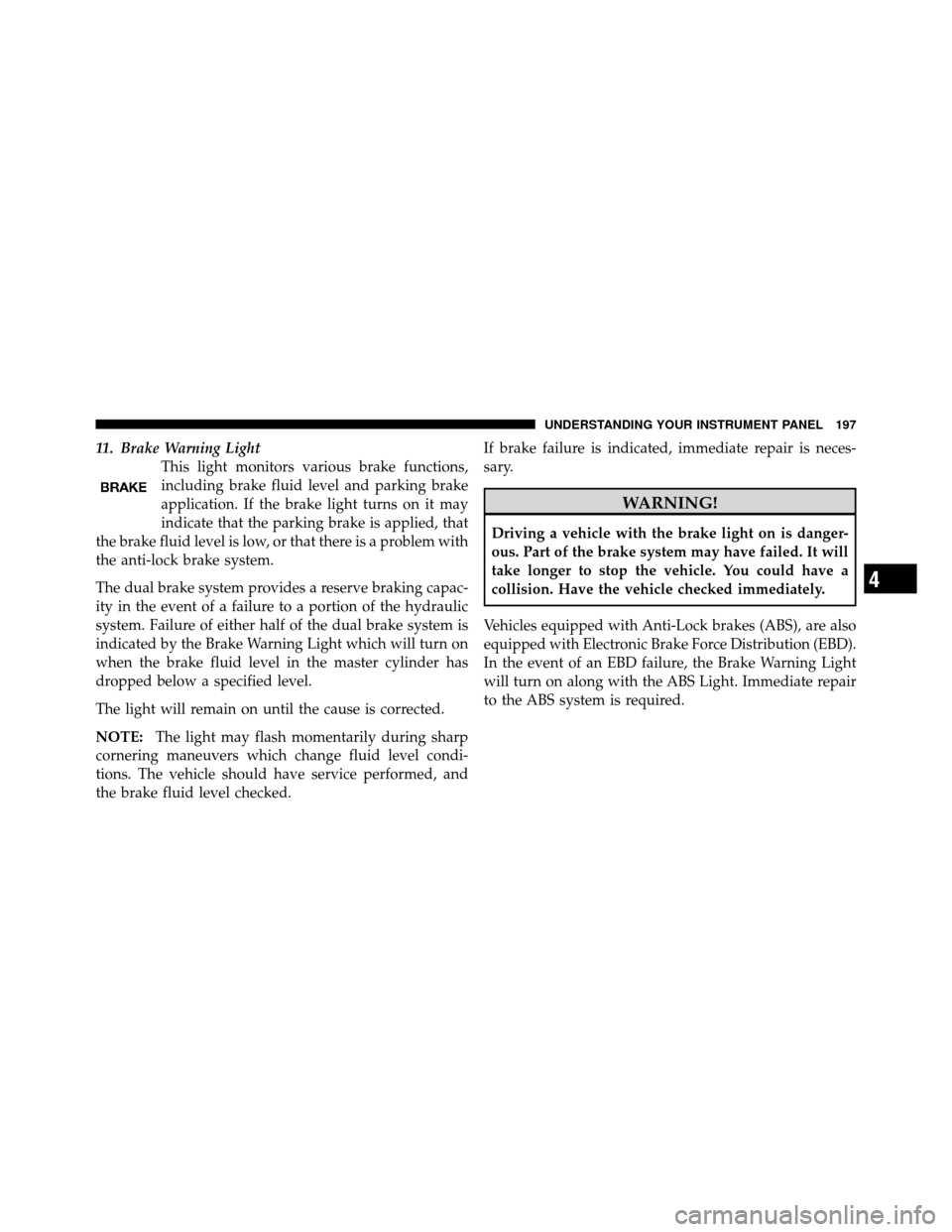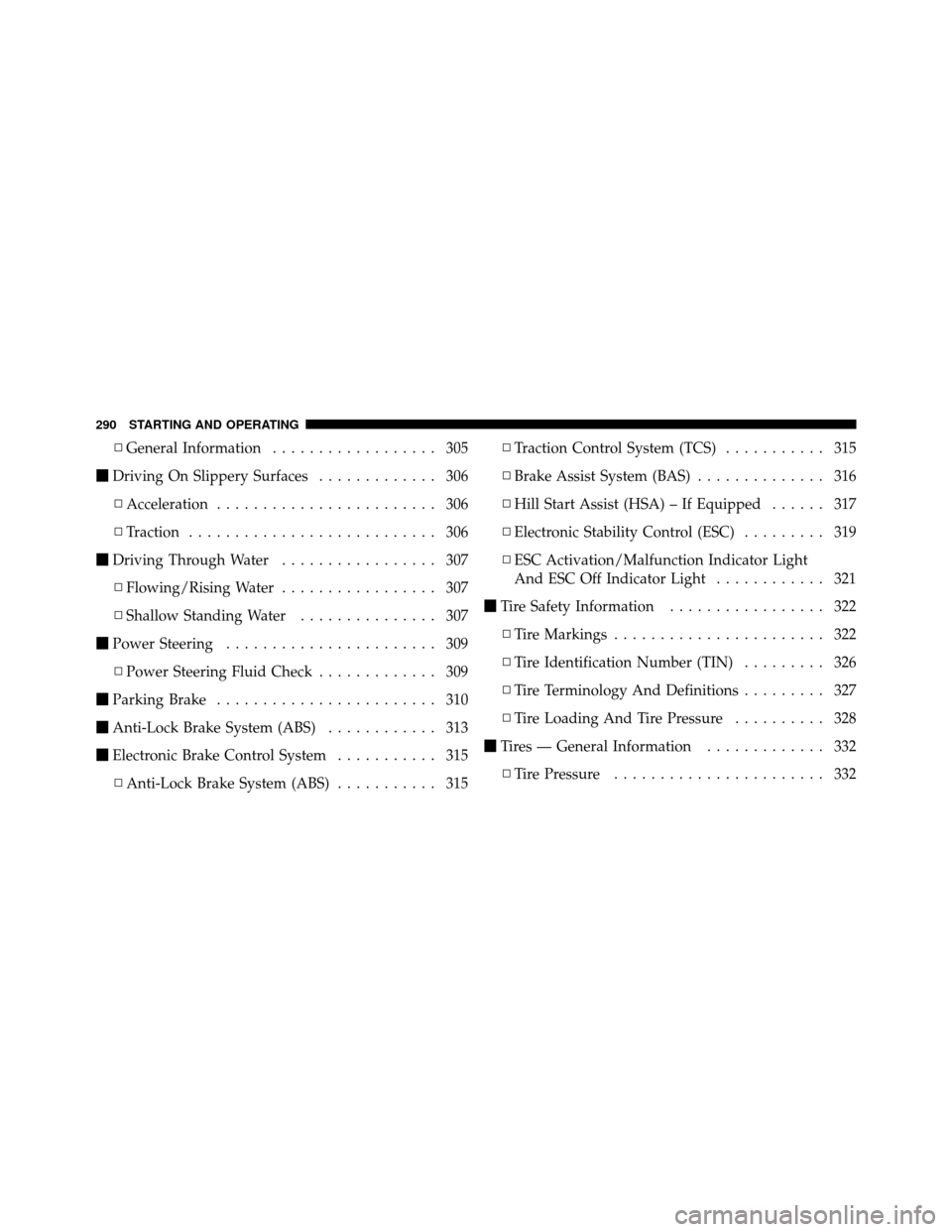Page 85 of 505
Periodic Safety Checks You Should Make Outside
The Vehicle
Tires
Examine tires for excessive tread wear and uneven wear
patterns. Check for stones, nails, glass, or other objects
lodged in the tread or sidewall. Inspect the tread for cuts
and cracks. Inspect sidewalls for cuts, cracks and bulges.
Check the wheel nuts for tightness. Check the tires
(including spare) for proper cold inflation pressure.
Lights
Have someone observe the operation of exterior lights
while you work the controls. Check turn signal and high
beam indicator lights on the instrument panel.
Door Latches
Check for positive closing, latching, and locking.
Fluid Leaks
Check area under vehicle after overnight parking for fuel,
engine coolant, oil, or other fluid leaks. Also, if gasoline
fumes are detected or if fuel, power steering fluid, or
brake fluid leaks are suspected, the cause should be
located and corrected immediately.2
THINGS TO KNOW BEFORE STARTING YOUR VEHICLE 83
Page 199 of 505

11. Brake Warning LightThis light monitors various brake functions,
including brake fluid level and parking brake
application. If the brake light turns on it may
indicate that the parking brake is applied, that
the brake fluid level is low, or that there is a problem with
the anti-lock brake system.
The dual brake system provides a reserve braking capac-
ity in the event of a failure to a portion of the hydraulic
system. Failure of either half of the dual brake system is
indicated by the Brake Warning Light which will turn on
when the brake fluid level in the master cylinder has
dropped below a specified level.
The light will remain on until the cause is corrected.
NOTE: The light may flash momentarily during sharp
cornering maneuvers which change fluid level condi-
tions. The vehicle should have service performed, and
the brake fluid level checked. If brake failure is indicated, immediate repair is neces-
sary.
WARNING!
Driving a vehicle with the brake light on is danger-
ous. Part of the brake system may have failed. It will
take longer to stop the vehicle. You could have a
collision. Have the vehicle checked immediately.
Vehicles equipped with Anti-Lock brakes (ABS), are also
equipped with Electronic Brake Force Distribution (EBD).
In the event of an EBD failure, the Brake Warning Light
will turn on along with the ABS Light. Immediate repair
to the ABS system is required.
4
UNDERSTANDING YOUR INSTRUMENT PANEL 197
Page 292 of 505

▫General Information .................. 305
� Driving On Slippery Surfaces ............. 306
▫ Acceleration ........................ 306
▫ Traction ........................... 306
� Driving Through Water ................. 307
▫ Flowing/Rising Water ................. 307
▫ Shallow Standing Water ............... 307
� Power Steering ....................... 309
▫ Power Steering Fluid Check ............. 309
� Parking Brake ........................ 310
� Anti-Lock Brake System (ABS) ............ 313
� Electronic Brake Control System ........... 315
▫ Anti-Lock Brake System (ABS) ........... 315▫
Traction Control System (TCS) ........... 315
▫ Brake Assist System (BAS) .............. 316
▫ Hill Start Assist (HSA) – If Equipped ...... 317
▫ Electronic Stability Control (ESC) ......... 319
▫ ESC Activation/Malfunction Indicator Light
And ESC Off Indicator Light ............ 321
� Tire Safety Information ................. 322
▫ Tire Markings ....................... 322
▫ Tire Identification Number (TIN) ......... 326
▫ Tire Terminology And Definitions ......... 327
▫ Tire Loading And Tire Pressure .......... 328
� Tires — General Information ............. 332
▫ Tire Pressure ....................... 332
290 STARTING AND OPERATING
Page 310 of 505

CAUTION! (Continued)
•Driving through standing water may cause dam-
age to your vehicle’s drivetrain components. Al-
ways inspect your vehicle’s fluids (i.e., engine oil,
transmission, axle, etc.) for signs of contamination
(i.e., fluid that is milky or foamy in appearance)
after driving through standing water. Do not con-
tinue to operate the vehicle if any fluid appears
contaminated, as this may result in further dam-
age. Such damage is not covered by the New
Vehicle Limited Warranty.
•Getting water inside your vehicle’s engine can
cause it to lock up and stall out, and cause serious
internal damage to the engine. Such damage is not
covered by the New Vehicle Limited Warranty.
WARNING!
•Driving through standing water limits your vehi-
cle’s traction capabilities. Do not exceed 5 mph
(8 km/h) when driving through standing water.
•Driving through standing water limits your vehi-
cle’s braking capabilities, which increases stop-
ping distances. Therefore, after driving through
standing water, drive slowly and lightly press on
the brake pedal several times to dry the brakes.
•Getting water inside your vehicle’s engine can
cause it to lock up and stall out, and leave you
stranded.
•Failure to follow these warnings may result in
injuries that are serious or fatal to you, your
passengers, and others around you.
308 STARTING AND OPERATING
Page 312 of 505

checked if a leak is suspected, abnormal noises are
apparent, and/or the system is not functioning as antici-
pated. Coordinate inspection efforts through an autho-
rized dealer.
CAUTION!
Do not use chemical flushes in your power steering
system as the chemicals can damage your power
steering components. Such damage is not covered by
the New Vehicle Limited Warranty.
WARNING!
Fluid level should be checked on a level surface and
with the engine off to prevent injury from moving
parts and to ensure accurate fluid level reading. Do
not overfill. Use only manufacturer’s recommended
power steering fluid.If necessary, add fluid to restore to the proper indicated
level. With a clean cloth, wipe any spilled fluid from all
surfaces. Refer to “Fluids, Lubricants, and Genuine
Parts” in “Maintaining Your Vehicle” for further
information.
PARKING BRAKE
Before leaving the vehicle, make sure that the parking
brake is fully applied. Also, be certain to leave the
transmission in PARK.
The parking brake lever is located in the center console.
To apply the parking brake, pull the lever up as firmly as
possible. To release the parking brake, pull the lever up
slightly, press the center button, then lower the lever
completely.
310 STARTING AND OPERATING
Page 404 of 505

▫Adding Washer Fluid ................. 419
▫ Exhaust System ..................... 419
▫ Cooling System ..................... 422
▫ Brake System ....................... 427
▫ Automatic Transmission ............... 429
▫ Appearance Care And Protection From
Corrosion .......................... 432
▫ Cleaning Center Console Cupholders ...... 438
▫ Convertible Top Care ................. 438
▫ Weather Strip Care – Soft And Hard Top .... 440
� Fuses .............................. 441
▫ Totally Integrated Power Module ......... 441
� Vehicle Storage ....................... 446 �
Replacement Bulbs .................... 446
� Bulb Replacement ..................... 447
▫ Headlamp ......................... 447
▫ Front Turn Signal .................... 449
▫ Front Fog Lamp ..................... 449
▫ Backup Lamps ...................... 450
▫ License Plate Lamp ................... 451
� Fluid Capacities ...................... 451
� Fluids, Lubricants, And Genuine Parts ....... 452
▫ Engine ............................ 452
▫ Chassis ........................... 453
402 MAINTAINING YOUR VEHICLE
Page 405 of 505
ENGINE COMPARTMENT — 2.4L
1 — Engine Coolant Reservoir7 — Air Cleaner Filter
2 — Power Steering Fluid Reservoir 8 — Engine Oil Fill
3 — Automatic Transmission Dipstick 9 — Coolant Pressure Cap
4 — Brake Fluid Reservoir 10 — Engine Oil Dipstick
5 — Integrated Power Module (Fuses) 11 — Washer Fluid Reservoir
6 — Power Distribution Center (Fuses)
7
MAINTAINING YOUR VEHICLE 403
Page 406 of 505
ENGINE COMPARTMENT — 3.6L
1 — Engine Coolant Reservoir5 — Air Cleaner Filter
2 — Power Steering Fluid Reservoir 6 — Engine Oil Dipstick
3 — Brake Fluid Reservoir 7 — Engine Oil Fill
4 — Totally Integrated Power Module (Fuses) 8 — Washer Fluid Reservoir
404 MAINTAINING YOUR VEHICLE